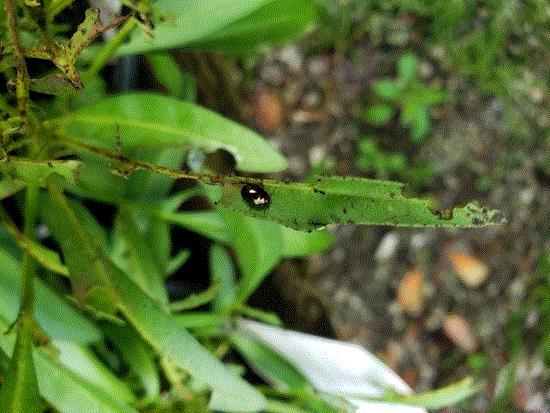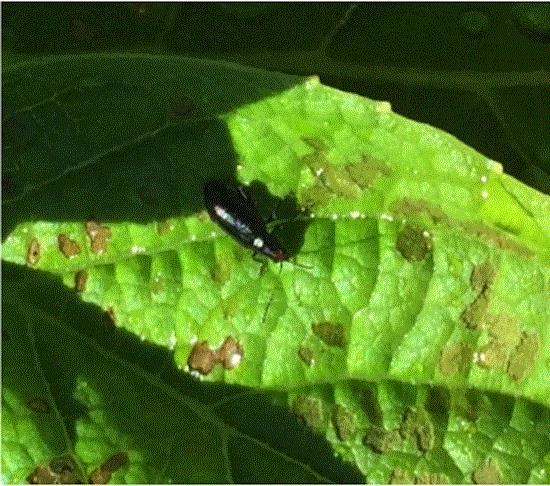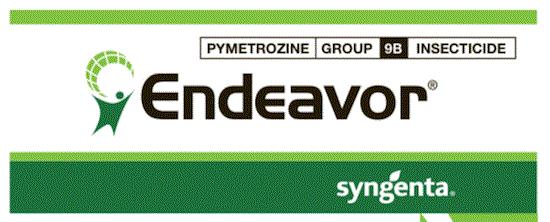What the ... ?
Davis Sanders of South Pleasantburg Nursery in Greenville, South Carolina, sent me a series of pictures (via Vicky Bertagnolli of Clemson Extension) featuring the coreopsis leaf beetle. Vicky identified the beetles and wondered what management plan Davis should Davis.
Coreopsis leaf beetle isn’t something that would elicit a “WOW!” Adults are just some 0.2-inch long, metallic purplish-brown beetles that hang out on coreopsis leaves. Larvae also feed on foliage, causing ragged, chewed-up leaves. Despite its look, coreopsis leaf beetle is actually a species of mystery. Although suggested by some researchers, no one knows for certain if the beetle is indeed a native southern son (or daughter). Records show that this species is distributed from South Carolina to Arkansas, Oklahoma and Texas. Mistaken identity (as a related species) has kept coreopsis leaf beetle living in anonymity until 1983.


Coreopsis leaf beetles on coreopsis. (Photo credit: Davis Sanders, South Pleasantburg Nursery.)
My old boss, Kris Braman, who is now the head of the Entomology Department at the University of Georgia, did a study 10-plus years ago on this beetle. Kris found that the peak abundance of larvae occurs in late March through early April, and that of adults occurs in early May in central Georgia. Additional sources suggest that adults lay eggs in the medium or soil, and most eggs hatch in the spring of next year. In Kris’ study, some eggs hatched in May, but no second-generation adults were observed. So, it’s probably safe to say that the coreopsis beetle larvae really do become active in the spring of the next year.
Kris reported that the adults and larvae feed on Coreopsis lanceolata, C. tinctoria, C. verticillata and Bidens aristosa. Other Asteraceae species planted in the same experimental gardens weren’t attacked. Davis reported that the beetles fed on coreopsis cultivars ”Early Sunrise” and “Dahl Baby,” and a small number fed on heliopsis.
What a fun little beetle! Not if you grow coreopsis.
What about management? Well, read on …
IR-4 publishes beetle efficacy summary
Funny that Vicky and Davis should ask about how to control the coreopsis leaf beetle. A couple of days before receiving this inquiry about coreopsis leaf beetle, I received the newest research summary from the IR-4 Project. This one is on efficacy against borers, beetles and grubs.
Coreopsis leaf beetle is an occasional pest, so neither the IR-4 Project nor other funding agencies have provided resources to study its control. But, we could make some educated guesses based on results from other leaf beetle species. IR-4’s beetle efficacy summary came at the perfect time!
The IR-4 Project evaluated the efficacy of 36 products against five leaf-feeding beetles in 30 trials since 2005. Among the currently available products, only bifenthrin (Talstar) caused mortality in black vine weevil adults, whereas acetamiprid (TriStar), bifenthrin (Onyx and Talstar), chlorantraniliprole (Acelepryn) and clothianidin + bifenthrin (Aloft) (all applied as foliar sprays) provided good to excellent reduction in foliar damage by Japanese beetle. Most tested products reduced viburnum leaf beetle population and damage when applied as a foliar spray, but clothianidin (Celero) and dinotefuran (Safari) provided the most consistent reduction.
For my all-time “favorite,” the redheaded flea beetle, no products provided consistent population reduction, but most products reduced damage in most trials (but not in my trials). Aloft and Tristar provided the most consistent reduction in damage by the redheaded flea beetle. Plants treated with Acelepryn, Bacillus thuringiensis galleriae (BeetleGone!), Chromobacterium subtsugae (Grandevo) and Tristar had the lowest leaf damage by the Sri Lankan weevil at seven days after one application. One study on European elm flea weevil reported that Aloft, tolfenpyrad (Hachi-Hachi) and Grandevo applied as foliar sprays, as well as Safari and imidacloprid (Xytect) applied as soil drench, reduced weevil damage compared to the untreated control.
For Davis’ coreopsis leaf beetle, since both adults and larvae feed on the leaves and adults are active only during a short period of time, the beetles can be managed with foliar spray on an as-needed basis. When the adults and larvae are active, foliar applications with most insecticides can be very effective in reducing the adult and larvae abundance. In my experience with the redheaded flea beetles, pyrethroids, neonicotinoids and cyantraniliprole (Mainspring) are excellent in knocking down adults. They should work well against the leaf-feeding larvae too. Pyrethroids have relatively short residual activity, so weekly application may be needed. With neonicotinoids and cyantraniliprole, Davis may get away with spraying every other week. If the larvae and adults ain’t there, no need to spray!

The redheaded menace! (Photo credit: JC Chong.)
The IR-4 summary also contains efficacy data for drench treatments against beetle grubs. Acelepryn, clothianidin (Arena and Celero), Safari and Talstar applied as pre-plant incorporation or preventive drench were more effective than curative drench against black vine weevil. IR-4 conducted a couple of experiments on Japanese beetle grubs, and none of these experiments demonstrated significant efficacy of medium drench of Acelepryn, neonicotinoids, acephate (Precise) and lambda-cyhalothrin (Scimitar). Preventive and curative drench with Acelepryn, Celero, imidacloprid + cyfluthrin (Discus), thiamethoxam (Flagship), imidacloprid (Marathon II), Safari, Talstar and trichlorfon (Dylox) were effective in reducing the number of Oriental beetle grubs. For strawberry rootworm, drench with Talstar or Orthene was the most effective treatment.
IR-4 has conducted efficacy trials against ambrosia beetles since 2004. Only the pyrethroids (such as bifenthrin or lambda-cyhalothrin) showed consistent efficacy in reducing attacks by the granulate ambrosia beetle and the black stem borer. Acetamiprid and Flagship significantly reduced emergence of bronze birch borer, whereas red maple trees treated with Discus suffered fewer attacks by flatheaded appletree borer. Drench application of Discus, Acelepryn, Mainspring and Safari, as well as spray application of Onyx, Scimitar and Tristar provided excellent control of peachtree borer. Data from a trial on banded ash clearwing borer were inconclusive. Note that only one trial was conducted for each of these pests: bronze birch borer, flatheaded appletree borer, banded ash clearwing borer and peachtree borer; data from these trials should be evaluated with more caution.
Visit the IR-4 website for a copy of the efficacy summary.

Expanded Endeavor label
Syngenta announced an expanded label for Endeavor (pymetrozine) last week. Endeavor is now labeled for use on cucurbits, eggplant, peppers, tomatoes, cole crops and leafy vegetables grown as transplants. The application rate for vegetable transplants is 2.75 oz. per acre by foliar spray only.
The expanded label also includes drench application for ornamentals. The drench rate is 5 oz. per 100 gallons, and 4 fl. oz. of insecticide solution should be applied to each 6-inch pot. Drench application should be made before pest populations become damaging because Endeavor is relatively slow in moving up the plant canopy when applied as a medium drench (when compared to neonicotinoids). Don't irrigate excessively after drench to avoid washing out the insecticide solution.
Endeavor is labeled against aphids and whiteflies. It interferes with the normal functions of the chordotonal organs in insects, causing them to stop feeding within a few hours. The insects don't die immediately so you’ll continue to find live insects for a few days after treatment. Don't freak out thinking that the treatment hasn't worked. Give time for the Group 9 insecticides, including Endeavor, Rycar and Ventigra, to take effect. The intoxicated insects, even though they're still alive, have stopped feeding and transmitting viruses, and will die over the next few days. Syngenta reports that Endeavor provides 14 to 21 days of aphid control and 14 days of whitefly control. The REI is 12 hours.

Visit the Endeavor website for more information. The expanded label wasn’t available on the website as of this morning. I downloaded a copy from Clemson University’s Department of Pesticide Regulations.

EPA’s draft guidance on PGRs and biostimulants
Do you use plant growth regulators (PGRs) in your operation? What about biostimulants for plant growth or pest resistance? Do you produce or sell PGRs or biostimulants? Pay attention if you do. EPA is seeking public comments on its draft guidance for PGRs and biostimulants. The goal of the draft guidance, entitled “Guidance for Plant Regulator Label Claims, Including Plant Biostimulants,” is to provide guidance to EPA staff and product registrants on whether a biostimulant is or is not a PGR.
A PGR is easy to understand. Biostimulants, on the other hand, can be a little tricky to define because it’s a new category of products with diverse offerings and claims in the marketplace. Plant biostimulants are hot! Many of them are naturally occurring compounds or microbes, and are becoming increasingly attractive to folks interested in sustainable agriculture. A plant biostimulant is not a fertilizer because it provides no nutritional value to the plants. But, it can promote greater nutrient and water use efficiency, increase resistance to pests and diseases, reduce abiotic stresses, and in turn, lead to plant growth and health.
EPA doesn't have a statutory definition for plant biostimulants. EPA is questioning whether plant biostimulants can influence plant growth and development through physiological processes in a way similar to PGRs. If so, plant biostimulants should be regulated as PGRs under FIFRA (Federal Insecticide, Fungicide, and Rodenticide Act). If plant biostimulants are classified as PGRs, there will be specific regulatory and product registration process, as well as specific guidelines on claims that could be made about the product. Depending on what the manufacturer or distributor of plant biostimulants may claim on their product labels, the product may or may not fall under FIFRA regulations.
Oh, the joy of learning and using governmentese!
Visit EPA’s website for information on submitting your comments. The deadline to comment is May 28.

AmericanHort and HRI want to know about your neonics
The last item of this week: AmericanHort and Horticulture Research Institute (HRI) want to better understand how our industry uses the nitroguanidine neonicotinoid insecticides and how restrictions on these insecticides may impact our use patterns. Nitroguanidine neonicotinoid insecticides include clothianidin (Arena, Aloft), dinotefuran (Safari, Zylam and others), imidacloprid (Marathon, Merit and others) and thiamethoxam (Flagship, Meridian and others).
Just a heads-up—EPA will soon propose some changes to the registration and labeling of these products. I’ll soon have a chance to direct you to the EPA website for comments. This survey will allow AmericanHort and HRI to better understand how the proposed regulations will impact our industry and how to represent our concerns.
The survey takes only two minutes to complete, and is anonymous. I did mine, and it took me less than a minute. Yes, my friend, I’m a survey machine!
Click on this link to participate in the survey.





See y'all next time!

JC Chong
Associate Professor of Entomology at Clemson University
This e-mail received by 25,155 subscribers like you!
If you're interested in advertising on PestTalks contact Kim Brown ASAP!